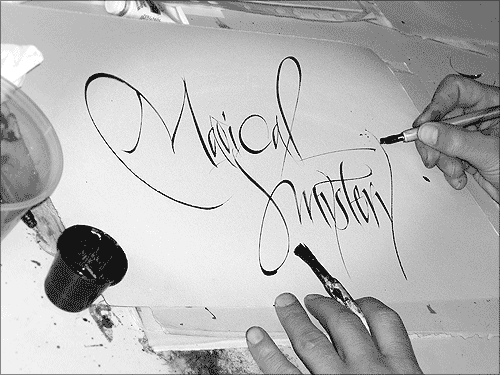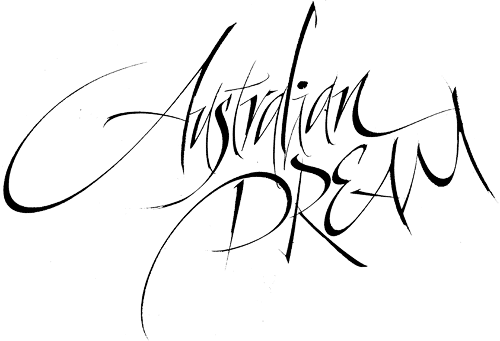Dangerous Lines Workshop
report by Bob Howe
2 day workshop for the Australian Society of Calligraphers, Sydney, May 2007Thanks to Bob Howe and the ASC for permissions to reproduce this review, first published in the ASC journal, 'Colophon', Vol. 28 no.3, June 2007.
It’s a bird, it’s a plane, it’s Supermaj … uscule!
Thus we attended and took part in a wondrous Denis Brown workshop. It was a great privilege to be taught by the Irish master calligrapher; it was awesome, and some. It was challenging and unsettling, for we were shaken out of our calligraphic complacencies; indeed, we’ll never write the same again. But above all, it was simply inspiring to watch the supermajusculer/minusculer in action as he, in illustrating his teaching, gave demonstration after magnificent demonstration.

Denis Brown live demo of 'Magical mystery' with lightning fast strokes
The script used for the purposes of the workshop was italic, wonderful, indispensable italic. The aim was to bring our respective italics into the contemporary world, if not there already; and if so, then more so! As shown by Denis, ways of doing this include: pen loading, writing speed, nib pressure, pen angle and manipulation, follow-through and other body movements; and RHYTHM. He taught a most convenient way of loading the pen, and how much ink to load; the angle of both nib and pen shaft; fine entry and exit strokes; flicks and pen manipulations — easy ones(!) and harder ones; and follow-through on long exits to facilitate cursive writing, along with other hand/arm movements, if not whole body! Follow through is very important, it helps the stroke maintain integrity. Think of a golfer. (I think of my golf and its divots). Writing like this is a bit of a workout, really, but these methods certainly help to make it more dynamic and lively. If in the real estate world it’s position, position, position, in the calligraphy world it’s rhythm, rhythm, rhythm! Rhythm is the pattern of marks, Denis explained, repeated either exactly or similarly throughout the work. All the strokes made must echo each other in some way, for a work to be rhythmic. This is achieved through equidistant stroke-making, and through serifs, joins and flourishes echoing each other’s shape, thickness and direction. Another way is variation on equidistance and slope, matters covered more fully in his polygamy, er polyrhythm, workshop. Rhythm then is an essential part of a work’s strength and unity, and it underpins all principles and elements of design. A study of Denis’s examples, as well as the work of others, including those who don’t achieve it, gives ample proof of this concept.
I want to hear your letters! Well, this is to paraphrase Denis, but he wants you to make a sound with your nib on the paper. And it sounds and feels great! It also seems to give you more authority with the pen. You are its ruler, so to speak. The Brause nib is not so stiff and unyielding after all. All this seems to engage the sense of touch more, especially when varying the pressure on the nib, to release more ink, make it go further. Pressure, more ink, release pressure; the pen skates, and it glides. Sings, even! It makes the whole experience more sensual, visceral, throughout as much of the body as you like. It seems to produce results!
 |
Denis Brown spontaneous demo in front of students
So generous was Denis with his teaching that Heather asked him, Aren’t you afraid that we’ll all end up writing like you? to which he replied, So what, they’ll never be as good. On this issue he at some length defined what should be the true aim: absorb his techniques and adapt them to our own style. He pointed out that that was how he himself developed as a calligrapher — absorbing the techniques of a whole variety of calligraphers over the years, e.g. this from Hermann Zapf, that from Donald Jackson, until eventually his own style emerged. So we should be able to avoid the following scenario at the next Royal Easter Show:
1st: Denis Brown
2nd: Denis Brown
3rd: Denis Brown
Highly commended: Denis Brown
And thank you for all the other entries, Denis Brown.
Nor must we allow it to pervade other areas of our lives, as with Jenny who, perhaps mindful of how fast Denis writes, got booked on the way for speeding, or someone else (alright — me) who, on going to MacDonalds for breakfast, asked for a big box of rehashed Denis Browns.
Further on the topic of style, Denis broached the concepts of traditional and contemporary. They are not mutually exclusive terms, he argued. Traditional was, is, and always will be contemporary, of its time. So-called traditional work can be a slavish imitation of styles of the past, out of context of its zeitgeist, and say nothing — thematically or stylistically — to the present; or it can be ‘contemporary’ but forget the calligraphic past it evolved from. Something is always contemporary if of its time, as well as traditional if using time-honoured principles. No doubt Arrighi, should we happen to step through a portal of time and go Writing with the Dinosaurs, would agree, since in the sixteenth century he too was ‘out there’. Typography great, Stanley Morrison wrote that Arrighi’s italic ‘possesses no archaisms to render dangerous its use as a model by moderns’. (Oscar Ogg, Three Classics of Italian Calligraphy, intro. p viii).
Another facet of Denis’s writing is its obvious joie de vivre, in both the doing it and the result, a quality he encouraged us to acquire. Above all, he urged, enjoy it! But to watch him write was to witness a picture of concentration and, even before putting pen on paper, intent, seeing in his mind, beforehand, where he wants a mark to be on the page (already he had declared, You have to know the shape you want before you make it). Or, in the parlance of sports commentators, entering the zone. Perhaps there is an element of meditation in it, though this was not canvassed. Right then, assume the position of the lotus! Advanced scribes, you may assume the shape of a pretzel!
Having become Zen masters, it’s a short step to flourishing, if a long sweep of the hand. A term to send the shivers down your pen, flourishing to Denis however is like spreading jam. Now here’s how he does it: start on the corner of the nib, bring down the whole nib, going along it at 0°, gradually turning the nib, more pressure, make sure there’s plenty of ink, use your fingers, use your elbow, whole body, vary the speed, come up on the left half the nib while twisting, a final flick with follow through, and there you have it! Yeah, right! Can I do this? Can I ride a bicycle doing a handstand on the seat? Do the hip hop on the dot of an i? On the telly tonight is 50 great movie one-liners, hosted by Bert Newton. Tell ‘im he’s dreamin’, comes to mind. And if I do dream it, I’ll record it. More seriously though, and ambivalence and self-doubt notwithstanding, small flourishes will do. No need for the pyrotechnical pen, to out-flourish flourish. One centimeter at a time seems the way to go. A thousand mile journey of a Denis Brown flourish starts with one step!(A Chinese chestnut made contemporary!) Or as Bjork (or is that baulk?) once said, It’s like, why doubt? Who needs the luxury of doubt?
Indeed, Denis presented varying degrees of what’s achievable, what’s within our particular reach. This was one of the beauties of the workshop: not to despair or forget where we’re at, but take it further. Alright — he may write in cursive, and I may write in curses — he may have announced, I think I’ll go really wild with this one, stood up, pushed his chair back to give himself room, and we may have stepped back — he sure knows how to spread a crowd — turned the page around, stood ready to strike, went SQUISH! a python wriggling across the page, right across, A3. Landscape! And not a spot of ink went off the planet! All this, but it remains that he encouraged us to keep working strictly within our limits yet aiming to push beyond them.

Cartoon by Bob Howe, with Denis portrayed as a screaming Celtic initial 'D'!
Dangerous Lines is an interesting title for that reason. Apart from being nice and catchy — the nib certainly catches doing such lines — and apart from its obvious meaning, it may allude to a more existential level, that to write such lines is to be free, and to be free is to let go, disinhibit, dissolve fear, confront demons that lie deeper than Titivillus, and talk perceived dangers which they feed on under the table. Perhaps it is there that the marks become individual, distinct, truly personal; and there to not only dream, but moves towards the dream. But not here: things heard after the workshop, like Great! Now I’m depressed! (as if to say, I'll never be able to do this) and I learnt everything, and nothing! (except for what you get when you write the word flick and accidentally link the ‘l ’ with ‘i’!). Nor must we panic our way to the self-help shelves, to reach for The Seven Habits of Highly Effective Flourishing, How to Become a Millionaire by Flourishing Properly, or Men are from Mars, Women from Venus, and Flourishing from Pluto.
Now for day two. Only kidding, but Denis did say first thing on day two, Now we’re going to write faster! Whereupon we informed him of some great Australian adjectives. So we left the fast writing to him. Calligraphy a performing art? You’d better believe it! Not quite the crowd in a boxing tent, we nevertheless emitted sighs of disbelief and admiration as Denis quick as a snake strike, fluid as an eel through water, would make a beautifully shaped mark. Or hover the pen back under a phrase, stop, study the lie of the letters, turn the paper a little, bring the pen to be at one with its shadow, no, that’s the flourish!
Prints of work like this were available to buy, at very affordable prices. Also available to squiz at were two portfolios containing many other prints of his stunning, beautiful work. In them were a multitude of examples illustrating the principles he taught, to be studied as well as admired. These, plus photocopies of his demonstrations Denis generously allowed us to make, are a reminder of why it is that to do a Denis Brown workshop is to feel exhilarated for days afterwards.
After that wore off, and the reality of discipline called, it seemed like some legendary Celtic Draco had swashed in, touched lightly down on some magical pen, then soared off on an endless flourish into the ether! And you think, What was that!
But should we dispense with angst and grab the swinging hook of its message, it just might haul us up into the dizzy heights of its ragged-edging slipstream.
Thanks to Bob Howe and the ASC, Sydney Australia, for permissions to reproduce this review, first published in the ASC journal, 'Colophon', Vol 28 no.3, June 2007.